 Last additions - Otsu 大津市 Last additions - Otsu 大津市 |

Chimaki were also sold for 500 yen. Chimaki is a small bundle of straw wrapped with paper. They throw these from the floats during the procession on the second day of the festival.Jan 06, 2009
|
|

Saigyo Sakura Tanuki-yama float is associated with the tanuki (raccoon dog) mask worn by salt vendor (shiouri) Jihei who started the festival.Jan 06, 2009
|
|

On the left were musicians from the Yutate-yama float. Jan 06, 2009
|
|

This float always heads the festival procession every year, while the other floats draw lots to determine their order in the procession.Jan 06, 2009
|
|

Jingu Kogo-yama floatJan 06, 2009
|
|

On the right were musicians from the Jingu Kogo-yama float. They performed separately, then together. Flutes, drums, and chimes.Jan 06, 2009
|
|

Jan 06, 2009
|
|
|

Saigyo Sakura Tanuki-yama float with musicians playing on the bridge. 西行桜狸山Jan 06, 2009
|
|

Between the Yutate-yama and Jingu Kogo-yama floats, they held a little event featuring the musicians from both floats.Jan 06, 2009
|
|

Performance outside the Otsu Matsuri Hikiyama Museum.Jan 06, 2009
|
|

Jan 06, 2009
|
|

As well as Otsu Hikaru-kun, official mascot of Otsu. He is based on the Genji Monogatari (Tale of Genji) character. おおつ光ルくんJan 06, 2009
|
|

Sesshoseki float at Otsu Matsuri.Jan 06, 2009
|
|

Lit lanterns and lit float.Jan 06, 2009
|
|

Inside a shopping arcade near the Otsu Matsuri Hikiyama Museum. There weren't any floats where we could actually enter.Jan 06, 2009
|
|

Inside Otsu Matsuri Hikiyama Museum is a life-size model of the Seiobo-zan (西王母山) float featuring a longevity peach and peach boy. 大津祭曳山展示館Jan 06, 2009
|
|

This float (called Seio Bo-zan) is inside the Maruya-cho shopping arcade. 丸屋町Jan 06, 2009
|
|

Otsu Matsuri lanternJan 06, 2009
|
|

Jan 06, 2009
|
|

Otsu Matsuri floats look better at night with the lanterns lit. Seeing the festival eve is well worth it. It's not so crowded either.Jan 06, 2009
|
|

Otsu Matsuri Hikiyama Tenjikan Museum (free admission) is in the Maruya-cho shopping arcade. 大津祭曳山展示館Jan 06, 2009
|
|

Nighttime viewJan 06, 2009
|
|

Jan 06, 2009
|
|

Karakuri dolls from Nishinomiya Ebisu-yama float.Jan 06, 2009
|
|

Daytime view. The distinguishing feature of Otsu Matsuri floats is that they have three wheels instead of four (as with Kyoto's Gion Matsuri).Jan 06, 2009
|
|

Daytime viewJan 06, 2009
|
|

Karakuri puppet from Ryumon Taki-yama on display. At Otsu Station, maps and pamphlets about the festival are available.Jan 06, 2009
|
|

The Otsu Matsuri has thirteen floats called hikiyama. Each one belongs to a different neighborhood in central Otsu. Each float has a name and features ornate carvings, tapestries, paintings, and other art work.Jan 06, 2009
|
|

Nighttime view during Yoimiya at Otsu Matsuri. Yoimiya is similar to the one held during the Gion Matsuri in Kyoto. 宵宮Jan 06, 2009
|
|

The floats also have elaborate tapestries, also removed for public display at street level. Two floats have tapestries depicting the Sack of Troy from Greek mythology.This one is from the Ryumon Taki-yama float.Jan 06, 2009
|
|

During the first day, the karakuri mechanical puppets are removed from the floats and displayed on street level. The karakuri ningyo puppets are a major highlight of the floats and festival. The puppets perform on the floats during the procession.Jan 06, 2009
|
|

Otsu Matsuri is one of Shiga's major festivals featuring thirteen ornate floats displayed and paraded around central Otsu over two days before Sports Day, a national holiday around Oct. 10.Jan 06, 2009
|
|

The first day of the festival has the floats parked and displayed on the streets and lit up at night. The first day of the festival is called Yoimiya. (This was Oct. 11, 2008.) 宵宮Jan 06, 2009
|
|

Bus service is also available along Hiei-zan Driveway.Jan 06, 2009
|
|
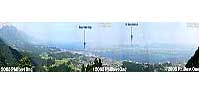
Panoramic view of Lake Biwa from Mt. Hiei.Jan 06, 2009
|
|

Jan 06, 2009
|
|

Garden Museum Hiei as seen from the lookout deckJan 06, 2009
|
|

Biwako Ohashi BridgeJan 06, 2009
|
|

Views of Lake Biwa from Hiei-zan Driveway. The city of Otsu.Jan 06, 2009
|
|

Entrance to Garden Museum HieiJan 06, 2009
|
|

Observation deckJan 06, 2009
|
|

Karasuma Peninsula in Kusatsu. There is a large lotus pond behind the windmill. About 20 min. by bus from JR Kusatsu Station.Jan 06, 2009
|
|

Lookout point along Hie-zan Driveway. This was my favorite.Jan 06, 2009
|
|

Observation tower in Garden Museum Hiei, a tourist attraction on the summit of Mt. Hiei.Jan 06, 2009
|
|

The final fireworks were half-dome explosions over the water. I missed it because I left early for the tiny train station on the Keihan Line.Dec 11, 2008
|
|

KittyDec 11, 2008
|
|

The crowd stretches very far down the shore.Dec 11, 2008
|
|

I sat here.Dec 11, 2008
|
|

This bridge seemed to be a favorite spot for photographers. It later was filled with standing-room only crowds.Dec 11, 2008
|
|

Dec 11, 2008
|
|
|

The tall building is Otsu Prince Hotel.Dec 11, 2008
|
|

People used to place these vinyl mats to save a fireworks viewing spot as early as 2 weeks before the fireworks date. However, from Aug. 2010, the city no longer allows this. You can save a spot only on the day of the fireworks.Dec 11, 2008
|
|

Pay money to watch the sky. I wonder if they actually filled up these seats. One of the most commercialized fireworks I've ever seen.Dec 11, 2008
|
|

The word on her fan says it all. Otsu, Shiga.Dec 11, 2008
|
|

Plastic mats are used to reserve spaces for groups. They would place these rocks, etc., to secure the mats. Some ill-mannered people would not bother to discard the sheets and rocks after the fireworks were over.Dec 11, 2008
|
|

Instead of going to Hama-Otsu Station, go to Shimanoseki Station (Keihan streetcar) to reach the free viewing area.Dec 11, 2008
|
|

A mass of people come to watch Lake Biwa Fireworks in summer. Free seating, finally. But located somewhat faraway from the prime site. びわ湖大花火大会Dec 11, 2008
|
|

Shiga Governor Kada Yukiko joins in. 滋賀県知事 嘉田由紀子Dec 11, 2008
|
|

浜大津と大津港の近辺では非常に不快感でした。柵で閉鎖されて有料の観客席だけ。最低の花火会場。Dec 11, 2008
|
|
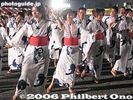
Dec 11, 2008
|
|

No entry. From Hama-Otsu, it was very difficult to figure out where the free viewing area was. These photos were taken on Aug. 11, 2006.Dec 11, 2008
|
|

Festival grounds after dark.Dec 11, 2008
|
|
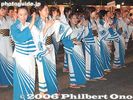
Dec 11, 2008
|
|
|
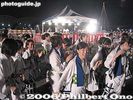
The festival's highlight is a local bon dance called Goshu Ondo. Also see the video at YouTube.Dec 11, 2008
|
|

Another major summer event in Otsu is the Biwako Fireworks held in Aug. Near Hama-Otsu and Otsu Port, the prime viewing place, almost the entire place was blocked off with walls and fences to give priority to paid spectator seats (several thousand yen).Dec 11, 2008
|
|
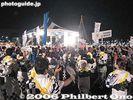
The dance area is very big. Many of the dance groups are from local companies.Dec 11, 2008
|
|

Yukata with a logo of Lake Biwa.Dec 11, 2008
|
|

Local dignitaries on stage, including Kada Yukiko, newly-elected governor of Shiga. 滋賀県知事 嘉田由紀子Dec 11, 2008
|
|

Ice sculpture contestDec 11, 2008
|
|

Overall winner with two salmon at Otsu Summer Festival. 優勝作品Dec 11, 2008
|
|

Okinawan eisa taiko drummer 琉友会Dec 11, 2008
|
|
|

Okinawan singerDec 11, 2008
|
|

Dec 11, 2008
|
|

Okinawan singerDec 11, 2008
|
|

Stage for entertainment and ceremonies. In 2006, the festival included a Balinese dancer, an Okinawan group, and ice sculpture contest.Dec 11, 2008
|
|

The Biwako Otsu Natsu Matsuri is an annual summer festival held on Aug. 1 at Hama-Otsu, near Otsu Port. びわ湖大津夏まつり Festival groundsDec 11, 2008
|
|

The festival starts at 5 pm with food stalls and a variety of entertainment. The stage is in the middle and the ice sculptures in the foreground. Food stalls ring the grounds.Dec 11, 2008
|
|

Arch gate to festival grounds.Dec 11, 2008
|
|

Nagara Shrine Honden Hall. The original shrine was atop the mountain, but it was later moved here in 1054 at the foot of Mt. Nagara to make it more accessible to worshippers.Jun 21, 2008
|
|

In 860, Miidera Founder Enchin worshipped this shrine as the guardian deity of Miidera.Jun 21, 2008
|
|

Built in 1905, gate of Nagara Jinja Shrine.Jun 21, 2008
|
|

Next to Miidera temple's southern boundary is Nagara Shrine. The shrine is not part of Miidera, but it is often included in maps of Miidera temple. 長等神社Jun 21, 2008
|
|

Behind the Kancho-do Hall is the Daishi-do Hall where Enchin is interred.Jun 21, 2008
|
|

Cherry blossoms and three-story pagoda at night.Jun 21, 2008
|
|

Beautiful cherry blossoms at night.Jun 21, 2008
|
|

Jun 21, 2008
|
|

Miidera cherry blossoms at night.Jun 21, 2008
|
|

Jun 21, 2008
|
|
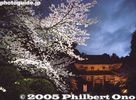
Cherry blossoms and the Niomon Gate at night in April.Jun 21, 2008
|
|
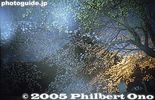
Cherry blossoms at Miidera temple, Shiga.Jun 21, 2008
|
|

Goho Zenjin-do Hall worships a guardian deity for children. Pray here for a safe childbirth and healthy growth of your kids. 護法善神堂Jun 21, 2008
|
|

Gate to Goho Zenjin-do HallJun 21, 2008
|
|

Another gate to Goho Zenjin-do HallJun 21, 2008
|
|

On the fringe of Miidera is Somon Gate 総門Jun 21, 2008
|
|

Soroban (Abacus) MonumentJun 21, 2008
|
|

Monument dedicated to Shiga Prefectural police officers.Jun 21, 2008
|
|

The stone marker on the right indicates where Emperor Meiji was when he visited here.Jun 21, 2008
|
|

The lookout point is like a park with various monuments.Jun 21, 2008
|
|

Kannon-do complex at Miidera temple, Shiga.Jun 21, 2008
|
|
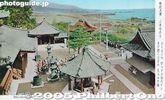
Vintage postcard view of the same scene in Miidera. Otsu was much less developed.Jun 21, 2008
|
|

Moon-viewing stage 勧月舞台Jun 21, 2008
|
|
|

Ema tablet pavilionJun 21, 2008
|
|

In front of the Kannon-do Hall is the water basin for purification.Jun 21, 2008
|
|

Ema tabletJun 21, 2008
|
|

Statue inside Kannon-do HallJun 21, 2008
|
|

Incense burner inside Kannon-do HallJun 21, 2008
|
|

Inside Kannon-do HallJun 21, 2008
|
|

Inside Kannon-do HallJun 21, 2008
|
|

Kannon-do Hall is the 14th temple in the Saigoku (Western Japan) pilgrimage circuit of 33 temples. Important Cultural Property 観音堂Jun 21, 2008
|
|

Kannon-do Hall, Miidera temple, ShigaJun 21, 2008
|
|

Inside bell towerJun 21, 2008
|
|

Bell tower next to Kannon-do Hall.Jun 21, 2008
|
|

Bell towerJun 21, 2008
|
|

Steps leading to the Kannon-do Hall on a hill in the southern precinct of Miidera.Jun 21, 2008
|
|

Side view of Kannon-do Hall.Jun 21, 2008
|
|

Bishamon-do Hall. 毘沙門堂Jun 21, 2008
|
|

Built in 1616, Bishamon-do Hall is an Important Cultural Property. 毘沙門堂Jun 21, 2008
|
|

Bishamon-do Hall and maple leaves. Should return in fall.Jun 21, 2008
|
|

Shuho Kannon. Worship her and become prosperous. 衆宝観音Jun 21, 2008
|
|

Jun 21, 2008
|
|

Tendai Daishi statueJun 21, 2008
|
|

Going toward the southern precinct of the temple, you see this Bimyoji temple with an 11-faced Kannon statue, an Important Cultural Property. The building was reconstructed in 1776. 微妙寺Jun 21, 2008
|
|

HydrangeaJun 21, 2008
|
|

Hydrangea in JuneJun 21, 2008
|
|

Stone wall and gate to Kangaku-in Hall at Miidera temple (Onjoji), school for priests and a National Treasure but closed to the public. 勧学院Jun 21, 2008
|
|

When the temple founder was crossing this bridge, a temple in China was ablaze. When he sprinkled water from a well, a mist arose from beneath the bridge and flew to extinguish the burning temple in China. 村雲橋Jun 21, 2008
|
|

Another building in the To-in area.Jun 21, 2008
|
|

In the center of the To-in complex is the Kancho-do Hall. Its a dojo exercise hall for entering the priesthood and conducting Buddhist initiation ceremonies. 潅頂堂Jun 21, 2008
|
|

On the left of the Kancho-do is the Chonichi Goma-do Hall. Important Cultural Property. 長日護摩堂Jun 21, 2008
|
|

Gate to the To-in complex, Miidera's most sacred area where Enchin (Chisho-Daishi) is buried and enshrined. All the buildings are Important Cultural Properties. 唐院Jun 21, 2008
|
|

Path to the To-in complex.Jun 21, 2008
|
|

Inside Issaikyo-zo HallJun 21, 2008
|
|

Inside Issaikyo-zo Hall is an octagonal, rotating Rinzo rack where the scriptures are stored.Jun 21, 2008
|
|

Lotus pondJun 21, 2008
|
|

Inside the Miidera Bell Pavilion, the source of the "Evening Bell at Miidera temple."Jun 21, 2008
|
|

It costs 300 yen to ring this bell once. (Not supposed to ring it more than once unless you pay again.) Also see my YouTube video here. 三井晩鐘Jun 21, 2008
|
|

There is a small opening where you can enter the bell pavilion to ring the gong. 鐘楼Jun 21, 2008
|
|

Kondo Main Hall, a National Treasure and Miidera's largest building. However, it was undergoing roof repairs in June 2008. Completed in fall 2008. 金堂Jun 21, 2008
|
|

Map of Miidera temple showing a variety of structures at the foot of Mt. Nagara (not Mt. Hiei). There are about 40 buildings, but you can enter only a few of them. It's not a huge complex, but allow at least 90 min. to see the major things.Jun 21, 2008
|
|

Back of Niomon Gate.Jun 21, 2008
|
|

Front of Niomon Gate. The name Miidera literally means "Three-Well Temple." It refers to three Emperors (Tenchi, Temmu, and Jito) who as newborns bathed in the temple's Akaiya well. "Mii" 御井 originally meant "sacred well.Jun 21, 2008
|
|

Daimon Gate (also called Niomon Gate) is the temple's front gate. Built in 1452 and transferred here from Jorakuji temple in Koka by Tokugawa Ieyasu in 1601. Important Cultural Property. 仁王門Jun 21, 2008
|
|

These photos were taken in both April during cherry blossoms season and in summer.Jun 21, 2008
|
|
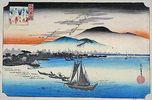
Another ukiyoe woodblock print by Hiroshige showing "Descending Geese at Katata" with Ukimido in the background. 近江八景「堅田の落雁」Jun 08, 2008
|
|

Ukiyoe woodblock print by Hiroshige showing "Descending Geese at Katata" with Ukimido in the foreground. 近江八景「堅田の落雁」Jun 08, 2008
|
|

View of Ukimido while rowing on Lake Biwa.Jun 08, 2008
|
|

Jun 08, 2008
|
|

With twin two-lane bridges, the 1.4-km north bridge (Katata to Moriyama traffic) was completed in 1994. The south bridge (1.35 km) was the original bridge completed in 1964 (for for Moriyama to Katata traffic).Jun 08, 2008
|
|

Also on the 2nd floor is an information room about Lake Biwa and Shiga.Jun 08, 2008
|
|

Omi rice made in Shiga.Jun 08, 2008
|
|

Katata pierJun 08, 2008
|
|

Jun 08, 2008
|
|

The hump at the center is about 26.3 meters above the lake surface allowing boats to pass under. If you bicycle around Lake Biwa, you can cross this bridge as a short cut. But I recommend cycling all the way down to central Otsu.Jun 08, 2008
|
|

Bridge traffic is well over 30,000 vehicles per day.Jun 08, 2008
|
|

The Biwako Ohashi Bridge spans the neck of Lake Biwa's panhandle between Moriyama and Katata, the lake's narrowest width. Completed in Sept. 1964, the bridge portion over the lake is 1.4 km long.Jun 08, 2008
|
|

About Biwako Ohashi Bridge.Jun 08, 2008
|
|

Biwako Ohashi as seen from the lookout deck on the 2nd floor. The bridge makes it almost 50 min. faster to go to the other side of the lake.Jun 08, 2008
|
|

Biwako Ohashi Kome Plaza lookout deck on the 2nd floor.Jun 08, 2008
|
|

Biwako Ohashi Bridge is a toll road (200 yen for ordinary passenger cars), but free for bicycles and pedestrians who can go on the sidewalk. There are actually two parallel bridges, making it a four-lane bridge. The additional bridge was built in 1994.Jun 08, 2008
|
|

Biwako Ohashi Bridge as seen from Biwako Ohashi Kome Plaza in Katata. 琵琶湖大橋Jun 08, 2008
|
|

Biwako Ohashi Kome Plaza facing the lake. It also has a lookout deck on the 2nd floor.Jun 08, 2008
|
|

Michinoeki Biwako Ohashi Kome Plaza, a shopping place for local produce. 道の駅びわ湖大橋米プラザJun 08, 2008
|
|
|

Inside Biwako Ohashi Kome Plaza. "Kome" means rice. On the first floor they sell local rice and produce.Jun 08, 2008
|
|

Biwako Aika (Lake Biwa Elegy) Monument and memorial for songwriter Okuno Yashio who was from Katata. Details about the song here. 琵琶湖哀歌の歌碑 堅田Jun 08, 2008
|
|

JR Katata Station on the JR Kosei Line along the western shore of Lake Biwa, Shiga. Local buses run to Ukimido and other places. There's also a bus which crosses the Biwako Ohashi Bridge to reach Moriyama on the other side. 堅田駅Jun 08, 2008
|
|

The accident occurred on April 6, 1941. The boys from Kanazawa were students at the No. 4 High School 第四高等学校 which today is Kanazawa University. The sad incident spurred Okuno to create this song.Jun 08, 2008
|
|

Biwako Aika 琵琶湖哀歌 (Lake Biwa Elegy) is a mournful song dedicated to the eight college rowers from Kanazawa, Ishikawa Prefecture and three rowers from Kyoto who died while practicing in waters off Takashima-cho, Haginohama beach when struck by stJun 08, 2008
|
|
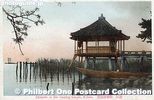
Vintage postcard of Ukimido floating temple before 1937 when the building was rebuilt. Flimsy stilts in comparison.Jun 08, 2008
|
|

Concrete stilts. Compare this with the next postcard image.Jun 08, 2008
|
|

Mt. Mikami in the distance.Jun 08, 2008
|
|

Bench on shore near UkimidoJun 08, 2008
|
|

North side of Ukimido. Haiku poet also visited Ukimido and wrote a haiku poem about it, displayed on a stone monument on shore.Jun 08, 2008
|
|

Altar facing the lake, with some of the 1,000 Amida Buddha figures.Jun 08, 2008
|
|

Altar facing the lake.Jun 08, 2008
|
|

Altar facing the shoreJun 08, 2008
|
|

View of Lake Biwa from Ukimido. The Biwako Ohashi Bridge can be seen in the distance.Jun 08, 2008
|
|

Concrete stilts reinforce the wooden stilts.Jun 08, 2008
|
|

Balcony looking toward Lake BiwaJun 08, 2008
|
|

Balcony facing the lake.Jun 08, 2008
|
|

Jun 08, 2008
|
|

View from the balcony.Jun 08, 2008
|
|
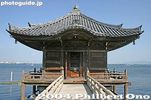
View from the bridge to Ukimido Floating Temple, Katata, Shiga. The building houses altars and 1,000 small Amida Buddha figures supposedly carved by Priest Enshin. Dedicated to transportation safety on the lake.Jun 08, 2008
|
|

Bridge from shoreJun 08, 2008
|
|

The Ukimido building itself has been rebuilt a few times over the centuries. It was first built in the 10th century by Priest Eshin (Genshin 源信) from Enryakuji temple on Mt. Hiei. The current temple building was built in 1937 and renovated in 1982.Jun 08, 2008
|
|

Ukimido floating temple in Katata, one of Shiga's most famous and picturesque buildings. One of the eight Omi Hakkei Views made famous by ukiyoe prints by Hiroshige.Jun 08, 2008
|
|

The scenic Ukimido has been the subject of ukiyoe woodblock prints (see below) by Hiroshige and other artists. You can walk on the short bridge to the Ukimido.Jun 08, 2008
|
|

Entrance to Ukimido Floating Temple, which is actually Mangetsu-ji temple. Admission is 300 yen. Hours: 8 am - 5 pm. Buses run from Katata Station. Parking available. 満月寺 浮御堂 MAPJun 08, 2008
|
|

Ishiyama-dera Tahoto pagodaApr 24, 2008
|
|

Sculpture of Lady Murasaki Shikibu at Ishiyama-dera, Otsu, Shiga.Apr 23, 2008
|
|

PR posterApr 23, 2008
|
|

Apr 23, 2008
|
|

Sculpture of Lady Murasaki Shikibu.Apr 23, 2008
|
|

Heading back through the Yume Kairo path.Apr 23, 2008
|
|

Sculpture of Lady Murasaki Shikibu.Apr 23, 2008
|
|

Lady Murasaki Shikibu's inkstone case.Apr 23, 2008
|
|

Painting of a scene from Tale of Genji on square paper.Apr 23, 2008
|
|

Inside 豊浄院 is more Genji-related exhibits.Apr 23, 2008
|
|

Sculpture of Lady Murasaki Shikibu.Apr 23, 2008
|
|

Lady Murasaki Shikibu's diary.Apr 23, 2008
|
|

Inside 豊浄院Apr 23, 2008
|
|

Path to 豊浄院Apr 23, 2008
|
|

Mannequin of Lady Murasaki Shikibu writing Tale of Genji. 紫式部源氏の間Apr 23, 2008
|
|

Mannequin of Lady Murasaki Shikibu writing Tale of Genji. 紫式部源氏の間Apr 23, 2008
|
|

豊浄院Apr 23, 2008
|
|

Ishiyama-dera temple Hondo main hall 本堂Apr 23, 2008
|
|

Room of Murasaki Shikibu and Genji. 紫式部源氏の間Apr 23, 2008
|
|

Ishiyama-dera temple Hondo main hall 本堂Apr 23, 2008
|
|

Inside the room of Murasaki Shikibu is a mannequin of Lady Murasaki Shikibu writing Tale of Genji. 紫式部源氏の間Apr 23, 2008
|
|

Near the entrance to the Hondo main hall is this Genji Monogatari folding screen replica.Apr 23, 2008
|
|

Genji Monogatari folding screen replica.Apr 23, 2008
|
|

密蔵院.Apr 23, 2008
|
|

密蔵院Apr 23, 2008
|
|

WaterwheelApr 23, 2008
|
|

明王院Apr 23, 2008
|
|

密蔵院 is another building with an exhibition.Apr 23, 2008
|
|

Steps to 密蔵院.Apr 23, 2008
|
|

Inside 密蔵院 was a robot exhibition. Only two robots on display, no resemblance to anything.Apr 23, 2008
|
|

WellApr 23, 2008
|
|

Gate to 密蔵院.Apr 23, 2008
|
|

Apr 23, 2008
|
|

Entering 明王院.Apr 23, 2008
|
|

View of 明王院.Apr 23, 2008
|
|

Inside 明王院 is an exhibition space showing works by award-winning novelist Tanabe Seiko 田辺聖子 who wrote a new version of Genji Monogatari.Apr 23, 2008
|
|

Souvenir shop and rest space.Apr 23, 2008
|
|

Next is the 明王院, another temple building.Apr 23, 2008
|
|

There's also a fine view of a rock garden outside.Apr 23, 2008
|
|

Next, we go out and head for the 明王院.Apr 23, 2008
|
|

Entrance to 世尊院.Apr 23, 2008
|
|

Another room in the 世尊院 showed more embroidery, mainly of flowers. The exhibition here will change a few times during 2008.Apr 23, 2008
|
|

Closeup of embroidery.Apr 23, 2008
|
|

Inside 世尊院. When I was there, beautiful embroidery showing scenes from the Tale of Genji was displayed.Apr 23, 2008
|
|

Entrance gate to Genji Millennium exhibitions. Admission 1000 yen to see both the exhibitions and temple.Apr 23, 2008
|
|

First you enter this building called 世尊院.Apr 23, 2008
|
|

Further along the Yume Kairo path.Apr 23, 2008
|
|

Walls with excerpts from the novel.Apr 23, 2008
|
|

Inside Daikokudo temple.Apr 23, 2008
|
|

Daikokudendo temple dedicated to Daikokuten. 大黒天堂Apr 23, 2008
|
|

Continuing on the Yume Kairo path.Apr 23, 2008
|
|

Soon you see the gate to Daikokudendo temple on the right.Apr 23, 2008
|
|

There's also the 金龍社 shrine in a pond.Apr 23, 2008
|
|

Inside 淳浄館. A collection of hanging scrolls written with waka love poems from Genji Monogatari. Free admission.Apr 23, 2008
|
|

The garden has a building called 淳浄館 which is an exhibition space. Buildings like this are usually not open to the public.Apr 23, 2008
|
|

Walk further down the Yume Kairo path and see the gate to another garden called 拾翠園.Apr 23, 2008
|
|

Cafe de Genji, which is actually a Japanese-style garden called Kofuen 公風園.Apr 23, 2008
|
|

Entrance to Cafe de Genji, an open-air garden where you can sit and have tea.Apr 23, 2008
|
|

Official mascot greets visitors on the main path to Ishiyama-dera temple.Apr 23, 2008
|
|
| 2449 files on 10 page(s) |
 |
 |
 |
8 |  |
|